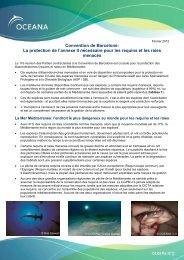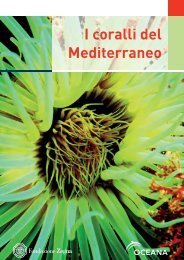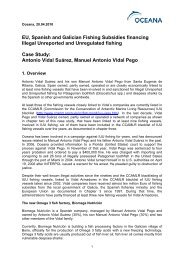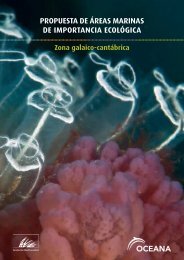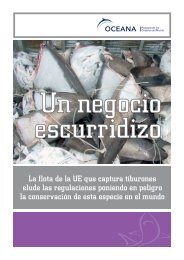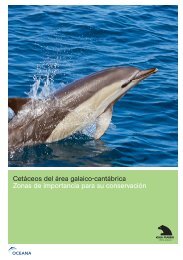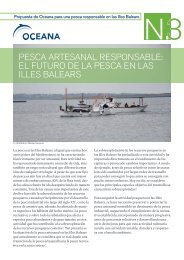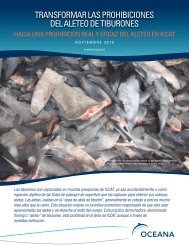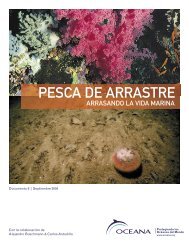Download - Oceana
Download - Oceana
Download - Oceana
Create successful ePaper yourself
Turn your PDF publications into a flip-book with our unique Google optimized e-Paper software.
OCEANAS PROPOSALS<br />
“Coral gardens” as a relatively dense aggregation of colonies or individuals or one or more coral species,<br />
supporting a rich associated fauna of benthic and epibenthic species, has been documented by OCEANA from<br />
15 m to 450 m depth.<br />
All the coral gardens recorded by OCEANA occur on hard seabed substrata, although bamboo gorgonian (eg:<br />
Isidella elongata and Keratoisis sp.) gardens have been described by scientists in the Atlantic Sea within the<br />
OSPAR maritime area. However, we consider that aggregations of solitary scleractinians (e.g.: Flabellum<br />
chunii) that occur in soft bottom can not be considered as “coral garden”, as they appear isolated and don’t<br />
form a “three-dimensional community”, characteristic of this habitat.<br />
The different taxonomic groups recorded by OCEANA that appear in the OSPAR maritime area as this<br />
“relatively dense aggregations of colonies or individuals” are hard corals (Scleractinia), black corals<br />
(Antipatharia), gorgonias (Gorgonacea) and leather corals (Alcyonacea). Stony hydroids (lace or hydrocorals:<br />
Stylasteridae) have been also recorded as a predominant habitat component and appear in dense<br />
aggregations in Canary Islands water (out of the OSPAR maritime area), but they were not recorded during the<br />
immersion sessions made in the OSPAR area. However it is possible that they occur in Portuguese areas<br />
(area V).<br />
With regard to sea pens (Pennatulacea), we consider that there is another habitat listed by OSPAR where this<br />
group is considered (“sea pens and burrowing megafauna), so we take the community dominated by<br />
Pennatulacea out of this habitat.<br />
The density of the predominant species in a coral garden is difficult to determine. The background document<br />
indicates coral species that can reach densities between 100 and 700 colonies per 100m 2 . In this sense, it is<br />
important to highlight that besides the density, the distribution of these species in the space must be<br />
considered, because it can be very variable. That is, we can have average figures or percentages for an area<br />
where the distribution of these species is very irregular (where there are high density and low density areas),<br />
as well as areas where the distribution of the species is more evenly spread.<br />
Furthermore, due to technical restrictions, we can not give a relative density of each of the species<br />
aggregation that we have considered, but we give some qualitative descriptions of each of them.<br />
Taking into account the necessity to define and describe the various habitats that must be considered as coral<br />
gardens, OCEANA proposes the following:<br />
1) Specific scleractinians, black corals and gorgonian gardens should be listed.<br />
2) Octocoral communities (Alcyonium spp., Corallium rubrum, etc..) should be added.<br />
3) Communities dominated by reef- forming hard- corals (e.g. Madrepora oculata) that occur in low density<br />
(not enough to create reefs) should be considered as “coral gardens”.<br />
4) The habitat “Lophelia pertusa reefs” should be modified to “Deep- sea coral reefs”, including in this form<br />
other reef- forming hard- corals species such as Madrepora oculata and Solenosmilia variabilis, species with<br />
which the Lophelia pertusa appears combined in many occasions, forming mixed reefs<br />
Detailed below are the different types of habitats that OCEANA proposes to be included as “coral gardens”:<br />
3



